HTML
--> --> -->Regarding the extratropical atmospheric forcings for ENSO occurrence, several studies have demonstrated that the winter North Pacific Oscillation (NPO, Fig. 1a), an important atmospheric intrinsic variability (Rogers, 1981; Linkin and Nigam, 2008; Song et al., 2016; Chen and Song, 2018), is able to impact the occurrence of ENSO in the following winter via the so-called “seasonal footprinting mechanism” (SFM) (Fig. 1b, Vimont et al., 2001; 2003; Alexander et al., 2010). In particular, as indicated by Vimont et al. (2001, 2003), the wintertime NPO-related atmospheric circulation anomalies can induce significant sea surface temperature (SST) anomalies over the tropical North Pacific during the following spring via changing the surface net heat flux, which in turn forces the overlying atmospheric circulation, including the westerly wind anomalies over the equatorial western Pacific (EWP). The westerly wind anomalies over the EWP further impact the outbreak of ENSO in the following winter via triggering an eastward propagating equatorial warm Kelvin wave (EWKW) (Vimont et al., 2003).
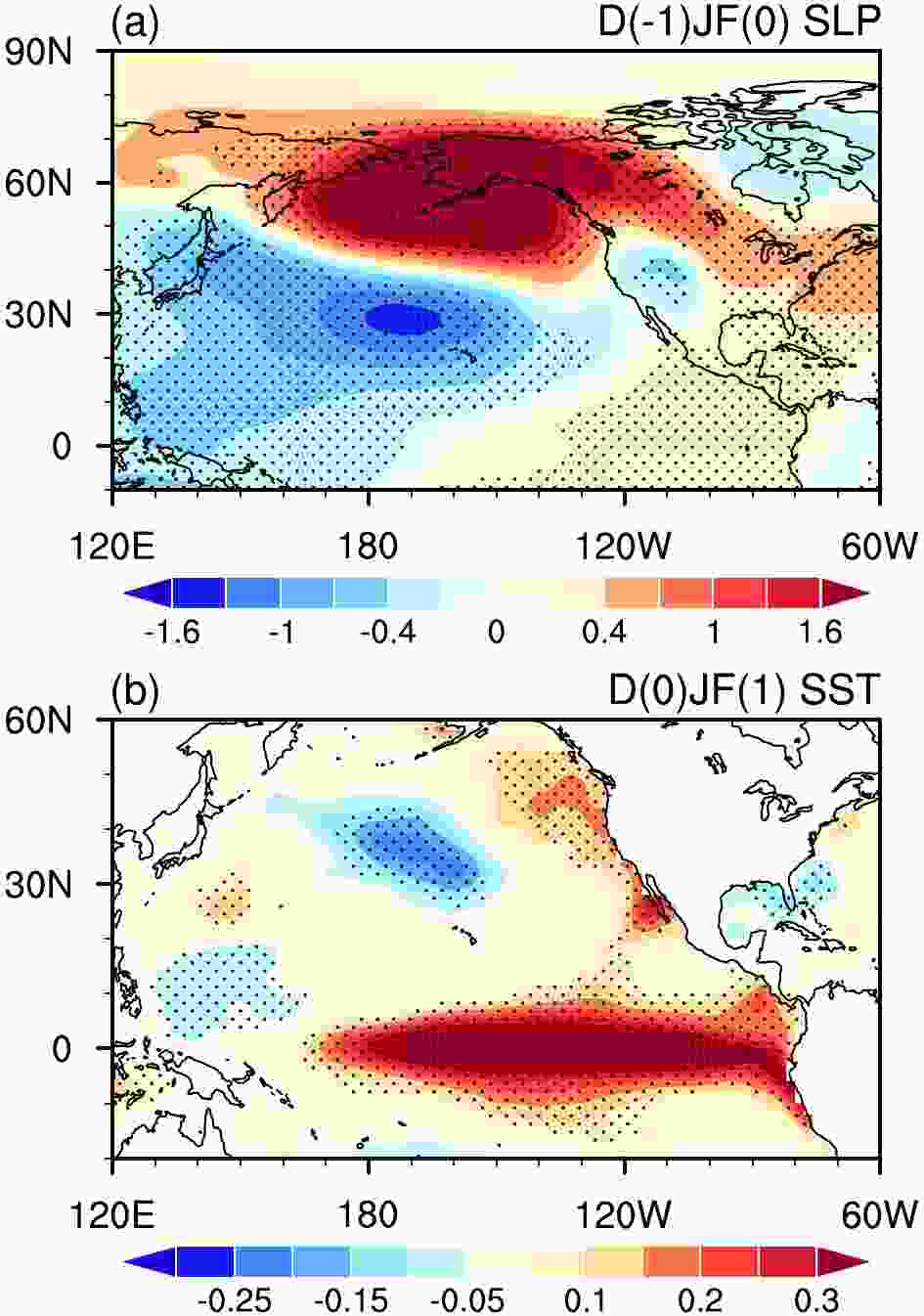 Figure1. Regression of (a) SLP anomalies (units: hPa) in D(?1)JF(0) and (b) SST anomalies (units: °C) in D(0)JF(1) onto the normalized D(?1)JF(0) NPO index during 1950?2016. Stippled regions indicate anomalies significant at the 5% level.
Figure1. Regression of (a) SLP anomalies (units: hPa) in D(?1)JF(0) and (b) SST anomalies (units: °C) in D(0)JF(1) onto the normalized D(?1)JF(0) NPO index during 1950?2016. Stippled regions indicate anomalies significant at the 5% level.Alexander et al. (2010) examined the connection between the winter NPO and ENSO through a coupled model. They found that about 70% of the model ensemble simulations reproduced the observed winter NPO-related SST anomalies in the tropical central-eastern Pacific (TCEP) during the following winter. In addition, Park et al. (2013) reported that about 41% of positive winter NPO years correspond to El Ni?o events during the following winter, which implies that the other 59% are not followed by El Ni?o events. The above evidence indicates that anomalous winter NPO years do not always correspond to an ENSO event during the following winter. Hence, the relationship between the winter NPO and ENSO might be modulated by other factors. Identifying the possible modulation effect of other factors has important implications for the prediction of ENSO based on the preceding winter NPO.
Several recent studies have found that the Atlantic Multidecadal Oscillation (AMO) (Kerr, 2000; Enfield et al., 2001), the leading SST variability over the North Atlantic on the multidecadal time scale, may significantly modulate the interannual relationships between ENSO and global climate systems (e.g., Geng et al., 2017; Li et al., 2018; Park and Li, 2019). For example, Geng et al. (2017) indicated that the connection between winter La Ni?a and the East Asian winter monsoon is strong (weak) during positive (negative) AMO phases. Park and Li (2019) suggested that the impact of ENSO on the SST in the tropical northern Atlantic (TNA) is strong (weak) during negative (positive) AMO phase. The above evidences motivate us to examine the interesting question of whether the AMO can modulate the relationship between the winter NPO and the following winter ENSO. In other words, this paper investigates modulation the AMO on the winter NPO?following winter ENSO connection.
As in Furtado et al. (2012), the winter [December?January?February (DJF)] average NPO index is defined as the difference in the area-averaged SLP anomaly between (55°?72.5°N, 180°?140°W) and (15°?27.5°N, 175°E?147.5°W). Results obtained in this study are not sensitive to reasonable changes of the above regions used to define the NPO index. In addition, using the EOF method to define the NPO index can also obtain similar results (not shown). The winter Ni?o3.4 index is defined as the area-mean SST anomaly over (5°S?5°N, 170°?120°W). The NPO index, Ni?o3.4 index, SST, winds, and precipitation fields were subjected to a 7-yr high-pass Lanczos filter to extract their interannual variations (Duchon, 1979). The significance levels of the correlation and regression coefficients were estimated based on the two-tailed Student’s t-test.
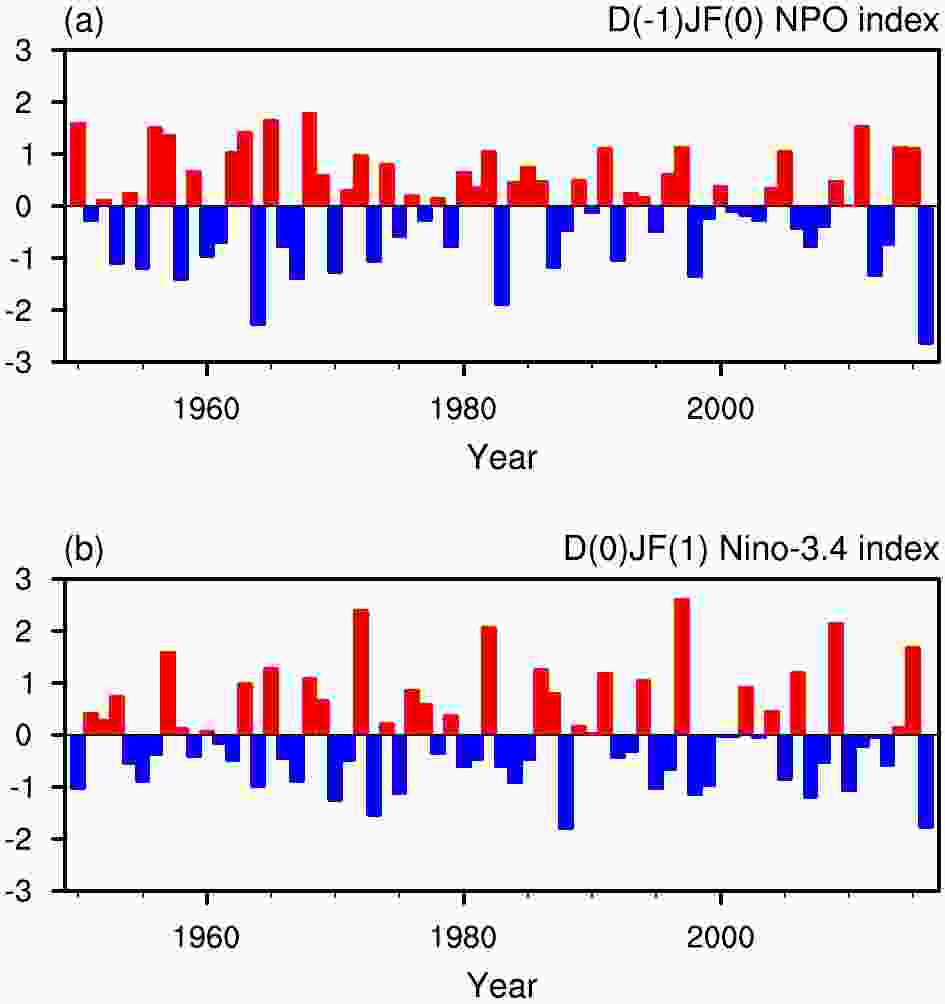 Figure2. Standardized time series of (a) winter NPO index and (b) following winter Ni?o3.4 index.
Figure2. Standardized time series of (a) winter NPO index and (b) following winter Ni?o3.4 index.We further examine the modulation effect of the AMO on the winter NPO?ENSO relationship. Figure 3a displays the 15-yr moving correlation coefficients of the winter NPO index with the following winter Ni?o3.4 index. The winter NPO index has a statistically significant correlation with the following winter Ni?o3.4 index from the early-1960s to the late-1990s (except around the early-1980s) (Fig. 2a), generally corresponding to the negative phase of the AMO (?AMO) (Fig. 2b). Furthermore, the connection between the winter NPO and the following winter ENSO is weak before the early-1960s and after the late-1990s (Fig. 2a), which corresponds to the positive AMO (+AMO) phase (Fig. 2b). Here, +AMO (?AMO) phases are considered as those years when the winter AMO index is larger (smaller) than zero. In particular, during the +AMO phase, the correlation coefficient between the winter NPO index and the following winter Ni?o3.4 index is weak (Fig. 4a; r = 0.19). In contrast, the winter NPO index has a strong positive correlation with the following winter Ni?o3.4 index during the ?AMO phase, with the correlation coefficient reaching 0.6, significant at the 1% level (Fig. 4b). The above evidence suggests that the AMO has a notable effect on the NPO?ENSO relationship. It should be mentioned that, during the period from the early- to mid-1980s, which corresponds to the ?AMO phase, the winter NPO has a weak correlation with the following winter Ni?o3.4 index. This suggests that the variation of the AMO cannot fully explain the change in the NPO?ENSO relationship. Besides the AMO, other factors may also play an important role in modulating the relationship between the winter NPO and the following winter ENSO. For example, Chen et al. (2013b) indicated that the spring Arctic Oscillation has a notable modulation effect on the NPO-related SFM. The combined impact of the AMO and other factors on the NPO?ENSO relationship remains to be explored.
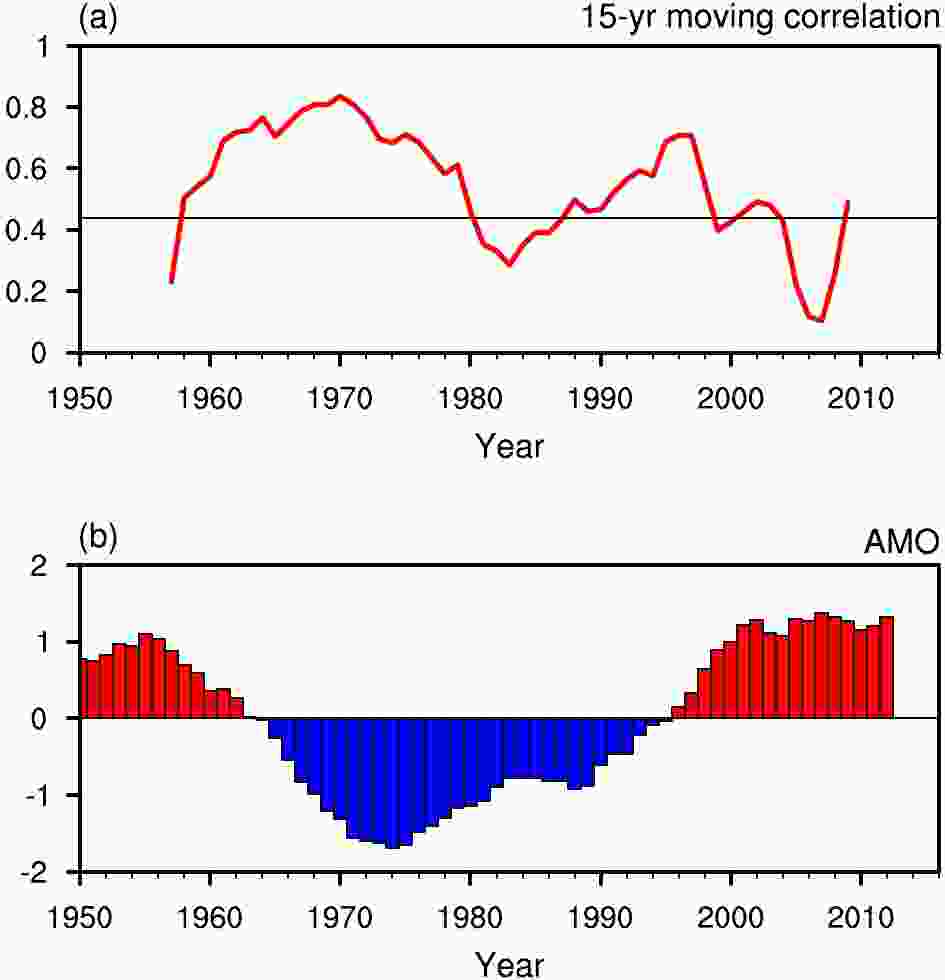 Figure3. (a) Fifteen-year moving correlation coefficient between the D(?1)JF(0) NPO index and D(0)JF(1) Ni?o3.4 index. The horizontal black line indicates the correlation significant at the 10% level. (b) The smoothed AMO index obtained from NOAA.
Figure3. (a) Fifteen-year moving correlation coefficient between the D(?1)JF(0) NPO index and D(0)JF(1) Ni?o3.4 index. The horizontal black line indicates the correlation significant at the 10% level. (b) The smoothed AMO index obtained from NOAA.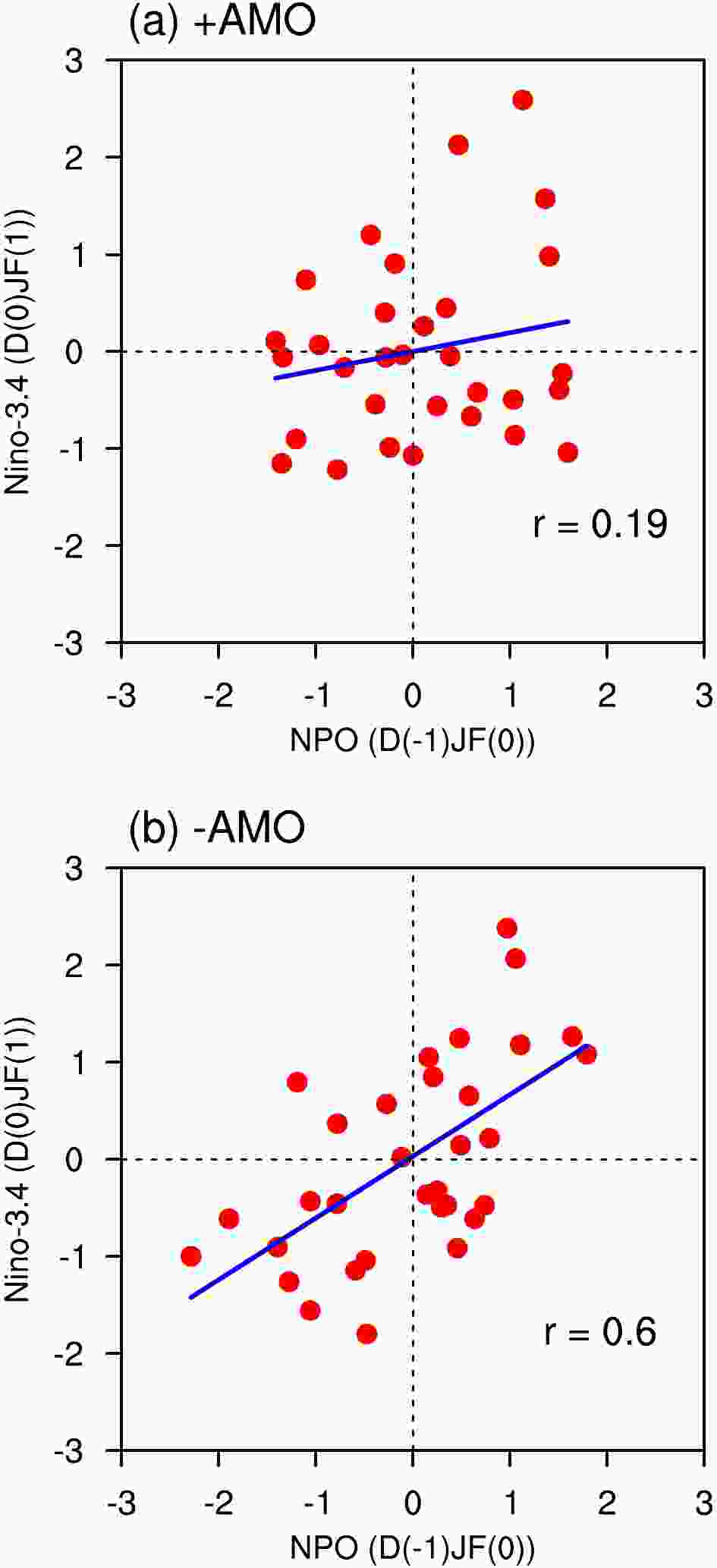 Figure4. Scatterplots of the winter NPO index against the following winter Ni?o3.4 index during (a) +AMO and (b) ?AMO phases.
Figure4. Scatterplots of the winter NPO index against the following winter Ni?o3.4 index during (a) +AMO and (b) ?AMO phases.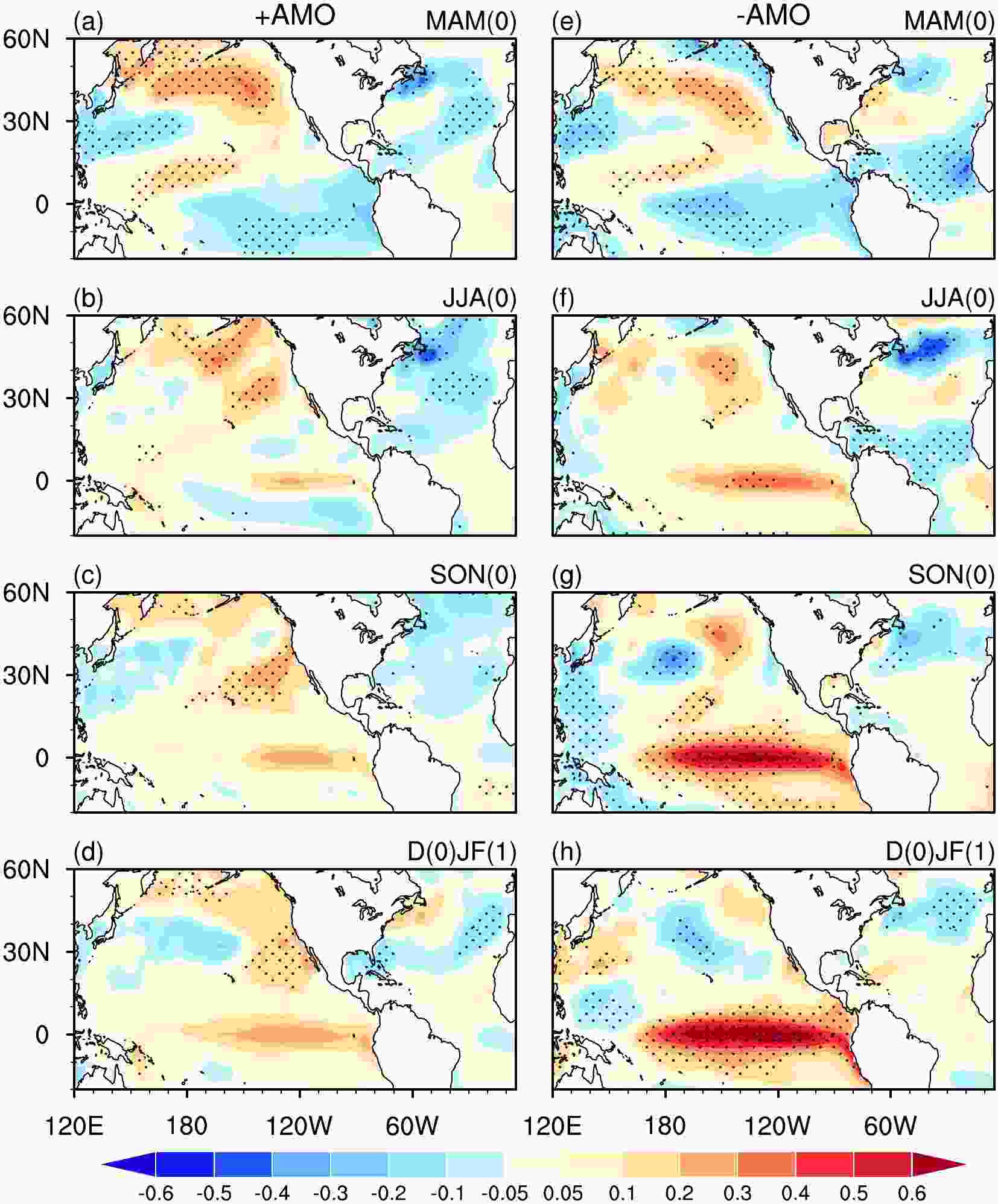 Figure5. SST anomalies (units: °C) in (a, e) MAM(0), (b, f) JJA(0), (c, g) SON(0), and (d, h) D(0)JF(+1) obtained by regression upon the normalized preceding D(?1)JF(0) NPO index during (left) +AMO and (right) ?AMO phases. Stippled regions indicate anomalies significant at the 5% level.
Figure5. SST anomalies (units: °C) in (a, e) MAM(0), (b, f) JJA(0), (c, g) SON(0), and (d, h) D(0)JF(+1) obtained by regression upon the normalized preceding D(?1)JF(0) NPO index during (left) +AMO and (right) ?AMO phases. Stippled regions indicate anomalies significant at the 5% level. Figure6. Anomalies of 850-hPa winds (vectors; units: m s?1) and precipitation (shading; units: mm d?1) in (a, e) MAM(0), (b, f) JJA(0), (c, g) SON(0), and (d, h) D(0)JF(+1) obtained by regression upon the normalized preceding D(?1)JF(0) NPO index during (left) +AMO and (right) ?AMO phases. Stippled regions indicate precipitation anomalies significant at the 5% level. Wind anomalies in both directions less than 0.2 m s?1 are not shown.
Figure6. Anomalies of 850-hPa winds (vectors; units: m s?1) and precipitation (shading; units: mm d?1) in (a, e) MAM(0), (b, f) JJA(0), (c, g) SON(0), and (d, h) D(0)JF(+1) obtained by regression upon the normalized preceding D(?1)JF(0) NPO index during (left) +AMO and (right) ?AMO phases. Stippled regions indicate precipitation anomalies significant at the 5% level. Wind anomalies in both directions less than 0.2 m s?1 are not shown.During +AMO, a tripole SST anomaly pattern can also be found in the North Pacific during spring (Fig. 5a). The amplitude of the SST warming in the tropical central North Pacific is comparable for the +AMO and ?AMO phases (Figs. 5a and e). However, the positive precipitation anomalies over the tropical central North Pacific, the cyclonic anomaly over the tropical western Pacific, and the westerly wind anomalies over the EWP are much weaker during +AMO than ?AMO (Figs. 6a and e). Correspondingly, the generated SST warming in the TCEP during the following summer is weaker during +AMO (Figs. 5b and f). As such, positive air?sea feedback cannot be well established in the tropics and an El Ni?o event cannot be induced in the following winter during +AMO (Figs. 5b-d and 6b-d). Hence, the impact of the winter NPO on the following winter ENSO is weak during +AMO.
The SST anomaly patterns in the TCEP in Figs. 5a and e bear several resemblances to the La Ni?a decaying phase?associated counterparts. It is known that ENSO has a strong autocorrelation (i.e., quasibiennial variability). In addition, studies have demonstrated that ENSO-related SST anomalies can exert an impact on the extratropical atmospheric anomalies (e.g., Alexander et al., 2002; Jia et al., 2009). But is the modulation effect of the AMO on the NPO?ENSO relationship impacted by the winter ENSO cycle? To address this issue, we removed the D(?1)JF(0) ENSO signal (represented by the Ni?o3.4 index) from the D(?1)JF(0) NPO index and all analyses fields by linear regression. Then, we re-examined the evolutions of the SST, 850-hPa wind, and precipitation anomalies from MAM(0) to D(0)JF(1) during different phases of the AMO (figures not shown). The results showed that the AMO still has an obvious modulation effect on the NPO?ENSO relationship after removal of the preceding winter ENSO signal. In particular, a significant impact of the winter NPO on the following winter ENSO can only be observed during the ?AMO phase. This result suggests that modulation of the NPO?ENSO relationship by the AMO is independent of the ENSO cycle.
The above analyses indicate that the AMO may impact the winter NPO?ENSO relationship via modulating the winter NPO-related spring precipitation anomalies over the tropical central North Pacific and westerly wind anomalies over the EWP. Stronger spring positive precipitation anomalies over the tropical central North Pacific during ?AMO could induce stronger spring westerly wind anomalies over the EWP, which exert a more significant impact on the occurrence of ENSO in the following winter. A further question is: what are the possible factors responsible for the differences in the winter-NPO-related spring positive precipitation anomalies over the tropical central North Pacific and westerly wind anomalies over the EWP during different AMO phases? It should be mentioned that the SST warming over the tropical North Pacific is similar during +AMO and ?AMO (Figs. 5a and e). This indicates that changes in the winter NPO-related precipitation anomalies over the tropical central North Pacific during different phases of the AMO may not be due to changes in the spring SST footprinting left by the winter NPO. Previous studies suggest that atmospheric convection can be more easily triggered by the same SST warming if the climatological precipitation is larger (e.g., Kim and Jin, 2011; Xiang et al., 2013; Ham and Kug, 2015). Weak climatological precipitation will suppress convection in response to SST warming because the upward motion anomalies need to overcome the climatological downward motion to result in convective activity (Kim and Jin, 2011; Xiang et al., 2013; Ham and Kug, 2015).
Figures 7a and b display the differences in the spring climatological SST and precipitation between ?AMO and +AMO (the former minus the latter). As expected, significant negative SST anomalies are seen in the North Atlantic (Fig. 7a). Significant SST anomalies can also be observed in the North Pacific, with SST warming in the tropical northeastern Pacific and around the tropical western Pacific extending northeastward to midlatitudes (Fig. 7a). Previous studies have indicated that the AMO can modulate the SST background state in the North Pacific via triggering anomalous Walker circulation (Zhang and Delworth, 2007; Xiang et al., 2013; Li et al., 2016; Sun et al., 2017). The processes responsible for the formation of the SST anomalies in the North Pacific can be referred to in the above studies. Significant negative precipitation anomalies are seen over the tropical western North Atlantic and midlatitudes as a response to the SST cooling there during ?AMO (Figs. 7a and b). In addition, the climatological precipitation over the tropical central North Pacific around (0°?20°N, 180°?120°W) is significantly larger during ?AMO than +AMO (Fig. 7b). Formation of this positive precipitation over the tropical central North Pacific may be due to the anomalous Walker circulation induced by the AMO, as has been discussed in previous studies (Hong et al., 2014; Chang et al., 2016; Li et al., 2016; Sun et al., 2017). In particular, SST cooling in the TNA during ?AMO could induce an anomalous Walker circulation over the tropics, with downward motion over the TNA (indicated by negative precipitation anomalies) and upward motion over the tropical central North Pacific (indicated by positive precipitation anomalies) (Li et al., 2016; Sun et al., 2017). This process explains the larger climatological precipitation over the tropical central North Pacific during ?AMO. Hence, the larger climatological precipitation over the tropical central North Pacific explains the stronger spring precipitation anomalies induced by the preceding winter NPO, as has been mentioned above, during ?AMO than +AMO in response to the similar SST warming there (Figs. 5a, e and 6a, e). The above evidence suggests that one of the pathways for the modulation impact of the AMO on the winter NPO?ENSO relationship is via modulating the climatological precipitation over the tropical central North Pacific.
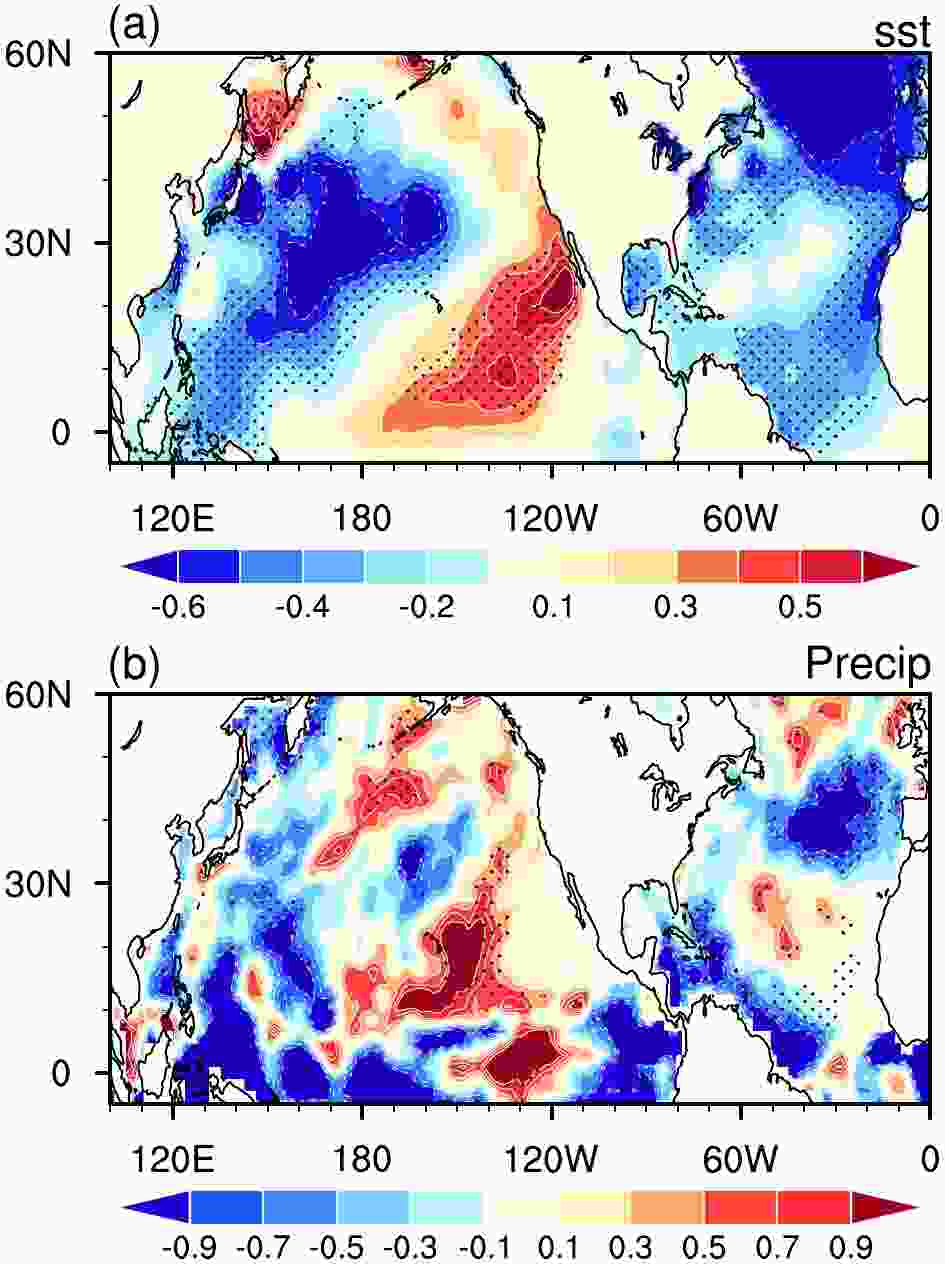 Figure7. Difference in the spring climatological mean (a) SST (units: °C) and (b) precipitation (mm d?1) between ?AMO and +AMO phases (former minus the latter). Stippled regions indicate the differences that are significantly different from zero at the 5% level.
Figure7. Difference in the spring climatological mean (a) SST (units: °C) and (b) precipitation (mm d?1) between ?AMO and +AMO phases (former minus the latter). Stippled regions indicate the differences that are significantly different from zero at the 5% level.In addition, we can deduce from Fig. 5 that significant differences exist in the spring SST anomalies in the TNA associated with the preceding winter NPO (Figs. 5a and b). Significant negative SST anomalies appear in the TNA in spring during ?AMO (Figs. 5e and f). However, SST anomalies are weak in the TNA during +AMO (Figs. 5a and b). Ham et al. (2013) suggested that negative SST anomalies in the TNA during spring are an important trigger for a following winter El Ni?o event via inducing significant westerly wind anomalies over the EWP. Hence, stronger westerly wind anomalies over the EWP induced by the winter NPO may also partly be due to the closer association of the winter NPO with the following spring TNA SST during ?AMO.
 Figure8. Schematic diagram of the modulation effect of the AMO on the impact of the winter NPO on the following winter ENSO.
Figure8. Schematic diagram of the modulation effect of the AMO on the impact of the winter NPO on the following winter ENSO.It is found that the AMO impacts the winter NPO?ENSO relationship mainly via modulating the winter-NPO-associated spring precipitation anomalies over the tropical central North Pacific and associated westerly wind anomalies over the EWP (Fig. 8). In particular, winter NPO-induced spring precipitation anomalies over the tropical central North Pacific and associated westerly wind anomalies over the EWP are much stronger during ?AMO than +AMO (Fig. 8). Stronger spring westerly wind anomalies further lead to a stronger impact of the winter NPO on the following winter ENSO during ?AMO (Fig. 8). Further analysis indicates that the AMO possibly modulates the winter-NPO-related spring precipitation anomalies over the tropical central North Pacific via changing the climatological mean precipitation there (Fig. 8).
In addition, it is noticed that significant negative SST anomalies can be observed in the TNA in the following spring associated with the preceding winter NPO during ?AMO. This significant spring SST cooling in the TNA may also partly contribute to the more significant connection between the winter NPO and the following winter ENSO during the ?AMO phase. The factor responsible for the change in the association between the winter NPO and the spring TNA SST remains to be explored.
Several studies have indicated that the spatial distribution of the winter NPO is crucial for the SFM (Park et al., 2013; Chen and Wu, 2018). Therefore, a question is: do significant differences exist between the spatial structures of the winter NPO over the North Pacific during different phases of the AMO? Figures 9a and b present the regression of winter SLP anomalies onto the simultaneous winter NPO index during +AMO and ?AMO phases, respectively. From Fig. 9, it is apparent that the spatial patterns of the winter NPO are similar over the North Pacific region in the two phases of the AMO. This corresponds to the similar SST anomaly pattern over the North Pacific during the following spring related to the winter NPO (Figs. 5a and e). This implies that the impact of the AMO on the winter NPO?ENSO relationship may not take place via modulating the spatial structure of the NPO.
 Figure9. Regression of SLP anomalies in D(?1)JF(0) onto the normalized simultaneous D(?1)JF(0) NPO index during the (a) +AMO and (b) ?AMO phases. Stippled regions indicate anomalies significant at the 5% level.
Figure9. Regression of SLP anomalies in D(?1)JF(0) onto the normalized simultaneous D(?1)JF(0) NPO index during the (a) +AMO and (b) ?AMO phases. Stippled regions indicate anomalies significant at the 5% level.Besides the AMO, it is generally recognized that the relationships between ENSO and several climate systems can also be modulated by the Pacific Decadal Oscillation (PDO) (e.g. Power et al. 1999; Duan et al., 2013). The PDO is the leading interdecadal SST variability pattern in the North Pacific (Mantua et al., 1997). But can the impact of the winter NPO on the following winter ENSO be modulated by the PDO? From Fig. 10, the winter NPO index has a close connection with the following winter Ni?o3.4 index during both phases of the PDO. The difference in the correlation of the winter NPO with the following winter Ni?o3.4 index is weak. This suggests that, in contrast to the AMO, the PDO does not have an obvious modulation effect on the impact of the winter NPO on the following winter ENSO.
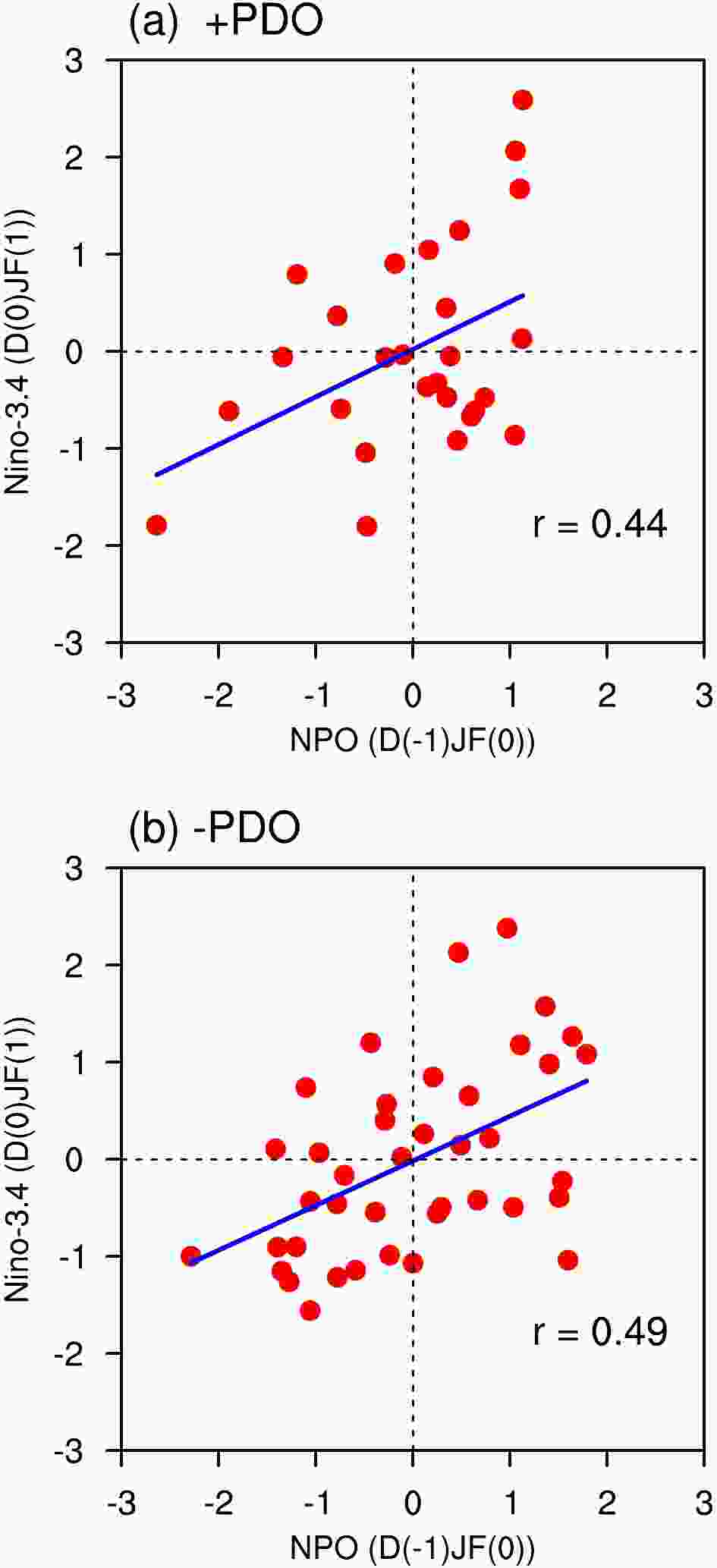 Figure10. Scatterplots of the winter NPO index against the following winter Ni?o3.4 index during (a) +PDO and (b) ?PDO phases.
Figure10. Scatterplots of the winter NPO index against the following winter Ni?o3.4 index during (a) +PDO and (b) ?PDO phases.Acknowledgments. We thank the two anonymous reviewers for their constructive suggestions, which helped to improve the paper. This study was jointly supported by the National Natural Science Foundation of China (Grant Nos. 41605050, 41530425, 41775080, and 41605031) and the Young Elite Scientists Sponsorship Program by China Association for Science and Technology (Grant No. 2016QNRC001).
